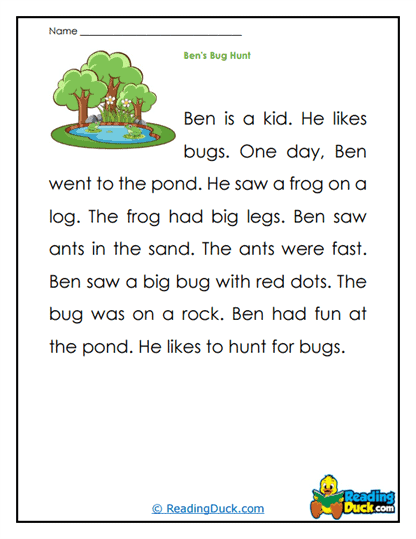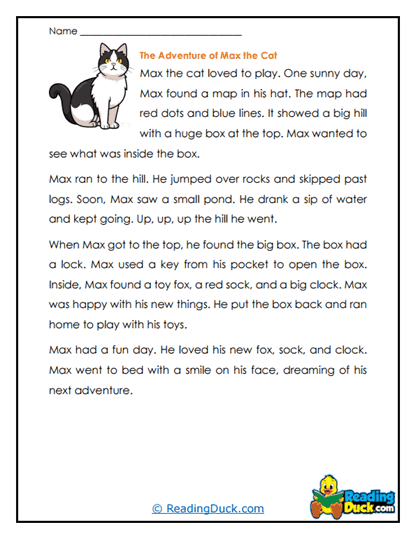Closed Syllables Reading Passages Worksheets
About Our Closed Syllables Reading Passage Worksheets
Our Closed Syllables Reading Passages Worksheets are designed to help students develop foundational phonics skills by focusing on closed syllable word patterns. Closed syllables, where a vowel is followed by one or more consonants (e.g., "cat," "sit," "mend"), are fundamental to early reading development. These worksheets offer targeted practice with closed syllable words, helping students improve their ability to decode and recognize these word patterns through meaningful reading passages.
Each worksheet is available in PDF format, making it simple for educators and parents to download, print, and integrate into classroom or home learning. Every worksheet also includes a downloadable answer key, providing a quick and easy reference for assessment, ensuring both students and educators have the tools they need to track progress effectively.
Through repeated practice with closed syllable word patterns, students can strengthen their phonics knowledge, improve reading fluency, and gain confidence in their reading abilities.
Key Features and Benefits
The Closed Syllables Reading Passages Worksheets provide a range of benefits that contribute to students’ literacy development. These worksheets focus specifically on closed syllable patterns, allowing for targeted phonics practice that can be seamlessly incorporated into various learning settings. Below are some of the primary features and benefits of this collection:
- Targeted Phonics Instruction: These worksheets emphasize closed syllables, such as words like "sun," "big," and "fish," which follow a short vowel sound closed by a consonant.
- Improved Word Recognition: By consistently encountering closed syllable words, students become more proficient at recognizing and reading these common word patterns, which strengthens overall word recognition.
- Enhanced Decoding Skills: The worksheets provide valuable practice in breaking down words into syllables, which helps students improve their decoding abilities and sound out new words more easily.
- Fluency Building: Reading passages that contain closed syllable words promote reading fluency, helping students increase both speed and accuracy over time.
- Real-World Application: The worksheets present closed syllable words within meaningful reading passages, allowing students to apply their phonics skills in context rather than isolated drills.
These features make the Closed Syllables Reading Passages Worksheets a valuable resource for developing essential reading skills in early readers.
Classroom Integration Tips for Teachers
Teachers can use the Closed Syllables Reading Passages Worksheets in various ways to enhance classroom instruction and engage students in effective phonics practice. Below are several practical tips on how to incorporate these worksheets into daily lessons:
- Group Reading Practice: Use the passages for group reading activities where students take turns reading aloud. This collaborative learning setting encourages peer support and helps students practice proper pronunciation and fluency with closed syllable words.
- Lesson Warm-Ups: Begin each phonics lesson with a short reading passage as a warm-up. This helps students focus on closed syllables right from the start and reinforces the day’s phonics goal.
- Phonics Centers: Integrate the worksheets into classroom phonics centers, where students can practice independently or with partners. These centers allow for differentiated instruction based on individual student needs.
- Independent Reading Practice: Assign the passages for students to read during independent work time, allowing them to build their phonics skills at their own pace while practicing closed syllables in context.
- Formative Assessments: Use the answer keys to assess students' reading progress and identify areas where additional phonics support is needed. This allows for ongoing monitoring and adjustment to meet students' individual learning needs.
By incorporating these strategies into their daily routine, educators can provide students with consistent and targeted phonics practice, making the worksheets an integral part of phonics instruction.
Supporting Literacy Development at Home
The Closed Syllables Reading Passages Worksheets are not just for classroom use—they’re also an excellent resource for parents and caregivers who want to support their child's literacy development at home. These worksheets are simple to integrate into daily routines and provide essential phonics practice that complements what students are learning in school. Here are several ways parents can use the worksheets to boost reading skills:
- Nightly Reading Practice: Assign one passage for nightly reading practice. Encourage your child to read aloud, focusing on proper pronunciation and fluency with closed syllable words. This consistent practice reinforces what they are learning in school and helps build confidence.
- Parent-Child Reading Sessions: Read the passages together, alternating paragraphs or sentences. This shared reading experience gives your child the opportunity to hear closed syllable words read aloud while improving their own pronunciation and fluency.
- Homework Reinforcement: Use the worksheets as a supplement to classroom instruction. Help your child complete the worksheet, then review their answers using the downloadable answer key. This allows for immediate feedback and correction.
- Repeated Reading for Fluency: Have your child read the same passage multiple times to build fluency. Repeated exposure to closed syllable words helps them become more comfortable and automatic in recognizing and reading these words.
- Positive Feedback: Track your child’s progress by noting improvements in their reading speed, accuracy, and confidence. Use praise and rewards to keep them motivated and engaged in their phonics practice.
With regular home practice, parents can provide valuable support in their child’s reading journey, ensuring that they build the foundational skills needed for long-term literacy success.
Building Foundational Phonics Skills with Closed Syllables
Closed syllables are one of the most common and important syllable types in the English language. Understanding how these syllables function is a critical step in developing strong phonics skills. Closed syllables are characterized by:
- Short Vowel Sounds: Closed syllable words, such as "bat," "cup," and "pen," contain a short vowel sound followed by a consonant.
- Consonant-Vowel-Consonant (CVC) Pattern: Many closed syllable words follow the CVC pattern, making them easy for early readers to decode and blend.
- Application to Multisyllabic Words: Once students master closed syllables in single-syllable words, they can apply this knowledge to reading multisyllabic words, such as "sunset" or "rabbit."
The Closed Syllables Reading Passages Worksheets focus on providing repeated exposure to these phonics patterns, helping students recognize closed syllable words with increasing accuracy and speed.
Supporting Fluency with Regular Practice
Reading fluency is a vital skill that contributes to overall reading comprehension and success. The Closed Syllables Reading Passages Worksheets provide ample opportunities for students to practice fluency by applying their phonics knowledge in connected text. Here’s how regular practice with these worksheets supports reading fluency:
- Improving Accuracy: The more students practice reading passages with closed syllable words, the more accurately they will be able to decode and pronounce these words.
- Increasing Speed: Fluency involves reading with both speed and accuracy. Repeated practice with closed syllable words in meaningful text helps students build reading speed without sacrificing understanding.
- Boosting Confidence: As students become more fluent with closed syllable words, they gain confidence in their reading abilities, which encourages them to tackle more complex texts.
By regularly practicing with the reading passages in this collection, students will make steady improvements in their reading fluency, which in turn will enhance their overall comprehension and enjoyment of reading.
Effective Tips for Maximizing Worksheet Use
To ensure students get the most out of the Closed Syllables Reading Passages Worksheets, both educators and parents can follow these practical tips:
- Set Specific Goals: Focus on a particular learning goal for each worksheet, such as improving decoding skills with a specific vowel sound or increasing reading speed.
- Encourage Repeated Practice: Repetition is key for mastering closed syllable words. Have students read the same passage multiple times to reinforce their phonics knowledge and build fluency.
- Integrate into Homework: Assign worksheets as part of your students' weekly homework to provide additional phonics practice outside of class.
- Track and Celebrate Progress: Use the answer keys to track students' progress and celebrate milestones such as improved reading accuracy or increased speed.
- Use in Phonics Centers: Make these worksheets part of a literacy or phonics center in your classroom, where students can work independently or in pairs to practice reading closed syllable words.
By following these tips, educators and parents can maximize the benefits of the worksheets, ensuring that students develop a strong foundation in reading through consistent and effective phonics practice.
Conclusion
The Closed Syllables Reading Passages Worksheets offer an essential resource for building foundational phonics and reading skills in early readers. By focusing on closed syllable word patterns, these worksheets provide targeted phonics practice that helps students improve their decoding abilities, word recognition, and reading fluency. Available in easy-to-use PDF format with downloadable answer keys, these worksheets are perfect for use in both the classroom and at home.
Through consistent practice with these worksheets, students will gain the skills and confidence they need to become proficient readers, laying a strong foundation for future academic success.









